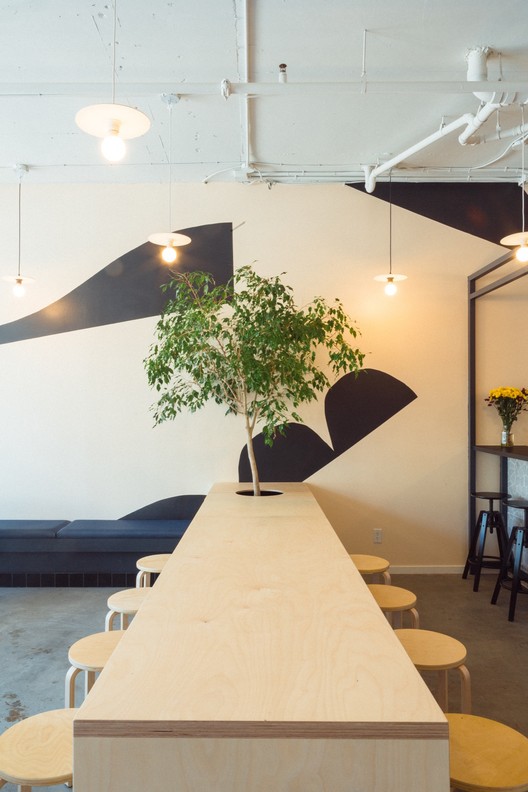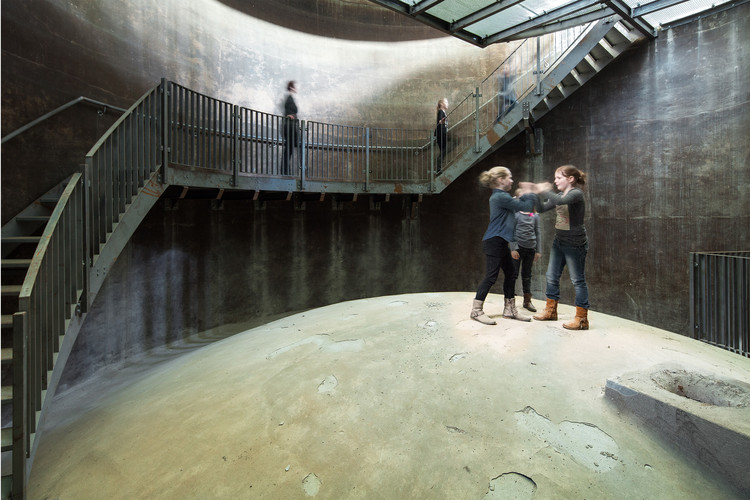Kutaisi ‘King David the Builder’ International Airport UNStudio
2013-11-14 01:00
架构师提供的文本描述。库泰西国际机场提供国内和国际航班,供游客、国家政治家和国际外交官使用。该机场将成为一个中心枢纽,2014至2015年将有多达100万游客参加,在格鲁吉亚这个越来越受欢迎的目的地庆祝休闲或活动假日。
Text description provided by the architects. Kutaisi International Airport serves domestic and international flights for use by tourists, national politicians and international diplomats. The airport will become a central hub, with up to one million travellers targeted in 2014-2015, celebrating a leisure or activity holiday anywhere in the ever more popular destination of Georgia.
UNStudio的新机场设计结合了佐治亚州的历史景观和建筑。在佐治亚州,公共建筑和私人住宅使用他们的入口大厅作为他们个人身份的展示。在新机场的设计中,UNStudio采用了这一建筑概念,以体现格鲁吉亚年轻和充满活力的民主,以及它作为该区域主要过境点的迅速发展。格鲁吉亚位于一个文化丰富的十字路口,有游客穿越高加索或从黑海抵达的历史。UNStudio的设计包括整个机场的发展,包括修订跑道、景观总体规划和规划的未来发展、航站楼、办公室、气象站和空中交通管制塔。机场的条例是严格的,包括欧洲和格鲁吉亚的标准,包括地震分区的8项要求。该项目是在UNStudio牵头咨询公司的领导下,在两年内设计和建造的,到2012年9月机场已经开始运作。在设计和建造方面,许多当地和国际公司都参与进来,开放和知识共享被证明是完成紧张的时间表所必不可少的。这座码头的钢结构-从匈牙利生产和运输-最近获得了欧洲钢铁奖。机场的实际数字显示,2014年春季每周有30个航班增加到40个,届时也可以从西欧直飞库泰西。
UNStudio’s design for the new airport incorporates both Georgia’s historic landscape and its architecture. In Georgia public buildings and private houses employ their entrance lobbies as showcases for their individual identities. In the design for the new airport UNStudio embraces this architectural concept in order to manifest Georgia’s young and dynamic democracy, along with its rapid development as a main crossing point in the region. Georgia is located on a crossroads of rich cultures, with a history of travellers passing through the Caucasus or arriving from the Black Sea. UNStudio’s design comprises the full airport development, including a revision of the runway, the master plan for the landscape and planned future development thereof, the terminal building, offices, a meteorological station and the air traffic control tower. Regulations for the airport were strict and comprised of a mix of European and Georgian standards, including earthquake zoning 8 requirements. The project was designed and constructed in two years, under lead consultancy of UNStudio, with the airport already having begun operations by September 2012. Both design and construction saw the involvement of numerous local and international companies, with openness and knowledge sharing proving to be essential to fulfilling the tight schedule. The steel structure of the terminal - produced and shipped from Hungary - recently won a European steel prize award. Actual figures of the airport show 30 flights per week increasing in spring 2014 to 40, by which time direct flights from Western Europe to Kutaisi will also be possible.
终端的体系结构是指一个网关,其中一个清晰的结构布局创建了一个包罗万象的保护卷。外部角落的细节-作为交叉点和识别点-以及候机楼内所谓的伞式结构-作为人流的回旋处-都是组织所有机场功能的两个主要建筑细节。雨伞进一步保证了从终点站广场到停机坪和地平线上的高加索地区的景色,反之亦然。伞的中心点是一个外露台,供离港旅客使用,中心区域四周的透明空间,是为了确保旅客流动畅顺,而离港和抵港的人流并不重合。该设计组织了物流流程,提供了最佳的安全保障,并确保旅客有足够的空间舒舒服服地循环。作为格鲁吉亚的大厅,候机楼还将作为咖啡馆和艺术画廊运作,展示格鲁吉亚年轻艺术家的作品,从而进一步体现当代格鲁吉亚文化。
The architecture of the terminal refers to a gateway, in which a clear structural layout creates an all-encompassing and protective volume. Both the exterior corner detail – which functions as a crossing-point and point of recognition - and the so called umbrella structure within the terminal building – which operates as a roundabout for passenger flows - operate as the two main architectural details around which all of the airport functions are organised. The umbrella further guarantees views from the terminal plaza to the apron and to the Caucasus on the horizon and vice versa. The central point in the umbrella is an exterior patio which is used for departing passengers. The transparent space around this central area is designed to ensure that flows of passengers are smooth and that departure and arrival flows do not coincide. The design organises the logistical processes, provides optimal security and ensures that the traveller has sufficient space to circulate comfortably. Serving as a lobby to Georgia, the terminal will in addition operate as a café and art gallery, displaying works by young Georgian artists and thereby presenting a further identifier of contemporary Georgian culture.
55米高的空中交通控制塔及其辅助办公/运营大楼的设计是为了补充终点站的设计。塔的强烈外观使它成为机场和周围地区的灯塔。顶层的交通控制室构成了塔楼的焦点,对周围的景观进行了360度的观察。宽敞舒适的室内确保了4-8个操作者的最佳工作空间。该塔的外部覆盖有一个穿孔的皮在混凝土核心,以利用风进行通风。在皮肤和核心之间的LED光增强了塔在黄昏和黎明时的信标效应,只要风速有波动,就会改变颜色。
The 55m high Air Traffic Control Tower and its supporting office/operational building is designed to complement the design of the terminal. The tower’s strong appearance makes it a beacon of the airport and surrounding area. The traffic control cabin on the top level forms the focal point of the tower, with a 360 degrees view on the surrounding landscape. A spacious and comfortable interior ensures a workspace for 4-8 operators with optimal concentration. The exterior of the tower is clad with a perforated skin on a concrete core to use wind for ventilation purposes. LED Light in-between the skin and the core enhance the beacon effect of the tower at dusk and dawn by changing color whenever there is a fluctuation in wind speed.
新机场的设计包括许多可持续发展的元素。大型地下天然水源通过混凝土芯的活化和洒水池的使用,为降低能耗提供了基础。航站楼和交通管制塔的楼层将利用这些水来维持两个体积内的规定温度。在终端建筑中,悬臂屋顶在南部和西南部地区提供遮阳。将混合低压通风系统集成到终端主体结构中,并在终端建筑底层设置了灰色集水系统。今后的一个目标是将库泰西机场作为格鲁吉亚第一个将废物严格隔离的机场,并建立一个可进一步落实到格鲁吉亚新的和现有项目中的回收系统。
The design for the new airport incorporates numerous sustainable elements. A large onsite underground source of natural water provides the basis for the reduction of energy consumption through concrete core activation and use for sprinkler basins. The floors of both the terminal and the traffic control tower will utilise this water for maintaining a regulated temperature in the two volumes. In the terminal building cantilevered roofs provide sun shading on south and southwest zones. A hybrid low pressure ventilation system is integrated into the terminal's main structure and there is a grey water collection system in the floor underneath the terminal building. A future aim is to present Kutaisi airport as Georgia’s first airport to incorporate a strict segregation of waste and establish a recycling system which could be further implemented into new and existing projects in Georgia.
 举报
举报
别默默的看了,快登录帮我评论一下吧!:)
注册
登录
更多评论
相关文章
-

描边风设计中,最容易犯的8种问题分析
2018年走过了四分之一,LOGO设计趋势也清晰了LOGO设计
-

描边风设计中,最容易犯的8种问题分析
2018年走过了四分之一,LOGO设计趋势也清晰了LOGO设计
-

描边风设计中,最容易犯的8种问题分析
2018年走过了四分之一,LOGO设计趋势也清晰了LOGO设计


































































